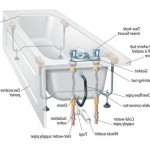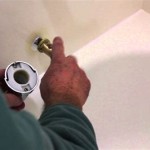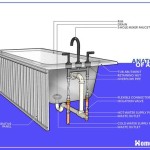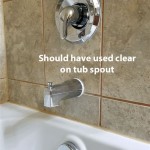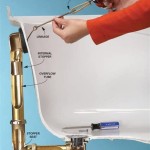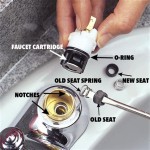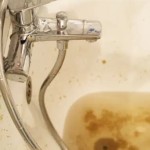Why Is Water Coming Out From Under My Bathtub?
Discovering water seeping from underneath a bathtub is a homeowner's concern that requires immediate attention. The presence of unexplained moisture indicates a potential leak, which can escalate into significant structural damage and costly repairs if left unaddressed. This article will explore the common reasons why water might be escaping from beneath a bathtub, focusing on identifying the source of the leak and outlining appropriate corrective actions.
The consequences of ignoring a bathtub leak can be severe. Prolonged exposure to moisture promotes mold and mildew growth, which poses health risks, particularly for individuals with respiratory sensitivities. Water damage can also weaken the subfloor, leading to costly repairs and potential structural instability. Therefore, a timely investigation and resolution are crucial for maintaining a safe and sound living environment.
Faulty Bathtub Drain and Overflow Assembly
One of the most frequent culprits behind water leakage under a bathtub is a problem with the drain and overflow assembly. This assembly consists of several components, including the drain flange (the visible part in the tub that accepts the stopper), the drainpipe connecting to the plumbing, and the overflow pipe designed to prevent water from exceeding the tub's edge. Each of these components is vulnerable to wear and tear, which can lead to leaks.
The drain flange, when not properly sealed against the bathtub surface, allows water to seep through the space between the flange and the tub. This seal is typically achieved with plumber's putty or a silicone caulk. Over time, these materials can dry out, crack, or shrink, compromising the seal. Similarly, the connection between the drain flange and the drainpipe beneath the tub can loosen or corrode, leading to leakage at the threaded joint or the rubber gasket.
The overflow pipe, generally located near the top of the bathtub side, has a similar potential for leakage. It is connected to the drainpipe with a series of pipes and fittings. The seals at these connections can fail, resulting in water escaping whenever the water level reaches the overflow drain during bathing. The overflow plate itself might also loosen or corrode, allowing water to seep behind it and into the surrounding wall cavity and potentially under the bathtub.
Diagnosis of a drain or overflow assembly leak often involves a process of elimination. Begin by visually inspecting the area around the drain and overflow for any signs of water damage, such as stains or discoloration. Next, fill the bathtub with water to a level just below the overflow drain and observe if any water appears under the tub. If no leak is apparent, fill the tub further until the water enters the overflow drain. If leakage now occurs, it strongly suggests a problem with the overflow assembly. A further test may be conducted by plugging the drain, filling the tub, and then monitoring the water level over several hours. A drop in water level, without any apparent use of the water, may indicate a slow leak within the drain assembly.
Repairing a drain or overflow assembly leak often requires replacing the faulty components. This may involve removing the old drain flange and overflow plate, cleaning the surrounding area, applying fresh plumber's putty or silicone caulk, and installing new, properly tightened hardware. If the drainpipe is corroded or damaged, it may also necessitate replacement. Depending on the complexity of the repair and the homeowner's plumbing skills, it may be best to consult a qualified plumber.
Cracked or Damaged Bathtub
The bathtub itself can develop cracks or sustained damage that permits water leakage. While fiberglass and acrylic bathtubs are generally durable, they are susceptible to impact damage from dropped objects or structural settling. Cast iron bathtubs, while more robust, can also crack due to stress or corrosion over an extended period.
Cracks can manifest in various locations on the bathtub surface, including the floor, the sides, and around the drain. Hairline cracks are often difficult to detect with the naked eye, but they can still allow water to seep through, especially when the tub is full. Larger, more obvious cracks pose a more significant and immediate leakage threat.
Damage to the bathtub's surface can also compromise its waterproof integrity. Chips, gouges, or delamination of the surface coating expose the underlying material to water, which can then penetrate and spread behind the tub. This is particularly concerning in areas where the bathtub interfaces with the surrounding walls or floor.
Identifying a crack or damage as the source of a leak requires careful visual inspection. Pay close attention to areas where stress is concentrated, such as around the drain, the corners, and along the edges of the tub. Look for even hairline fractures, discoloration, or bulging in the material. A simple test involves drying the bathtub thoroughly and then filling it partially with water. Observe the underside of the tub or the surrounding area for any signs of moisture appearing over the next few hours. If moisture does appear, mark the affected area on the bathtub's surface for further examination.
Repairs for cracked or damaged bathtubs vary depending on the severity and location of the damage. Small hairline cracks may be repairable with epoxy or specialized crack-filling compounds designed for bathtub surfaces. Larger cracks or significant damage often require professional repair services, such as fiberglass or acrylic repair, or even bathtub replacement. Simply patching a crack might not provide a long term solution as water may still be able to penetrate causing further damage. Ignoring a cracked tub can lead to the tub eventually breaking completely from the weight of the water.
Plumbing Connection Issues
The network of pipes connecting to the bathtub, including the supply lines for hot and cold water and the drainpipe, is a possible source of leaks. These pipes are typically located behind the bathtub or in the wall cavity. Leaks at these connections can be difficult to detect because they are often concealed. Corrosion, loose fittings, and damaged pipes can all contribute to this problem.
Pipe joints, whether threaded, soldered, or connected with compression fittings, are prime locations for leaks. Over time, the seals at these joints can degrade due to temperature fluctuations, water pressure variations, or corrosion. Loose fittings allow water to drip or spray out, while corroded pipes can develop pinhole leaks or weaken to the point of rupture.
Supply lines, typically made of copper, PEX, or flexible supply tubes, can also be vulnerable. Copper pipes are subject to corrosion, especially in areas with acidic water. PEX pipes, while more resistant to corrosion, can be damaged by improper installation or exposure to sunlight. Flexible supply tubes can kink or crack over time, leading to leaks.
Diagnosing plumbing connection issues requires meticulous inspection. Access to the pipes behind the bathtub may involve removing an access panel or cutting into the wall. Look for any signs of water stains, corrosion, or dripping water around the pipe connections. A dry paper towel waved under suspected leak points can reveal the presence of even minor leaks. A plumber's stethoscope or an electronic leak detector can also be used to pinpoint concealed leaks.
Repairing plumbing connection leaks typically involves tightening loose fittings, replacing corroded pipes or fittings, or re-soldering joints. If the damage is extensive, it may be necessary to replace entire sections of piping. Depending on the homeowner's plumbing experience, a professional plumber may be required to ensure the repairs are performed correctly and to code. A professional plumber may perform a pressure test of the plumbing system to verify all connections are sound.
Addressing water leakage under a bathtub promptly is crucial for preventing extensive damage. A systematic approach to identifying the source of the leak, followed by appropriate repair measures, is essential. While some repairs can be undertaken by knowledgeable homeowners, complex plumbing issues warrant the expertise of a licensed plumber to ensure the problem is resolved safely and effectively.

Why Is There Water Leaking From Underneath My Bath Gas Tech Heating

Why Water Might Be Coming Out Of Bathtub Drain Instead Going Down Plumbing Pipe Problems

5 Reasons Your Bathtub Is Leaking And How To Fix It Fast

Water Leaking From Under The Bathtub Possible Causes And Solutions

How To Fix A Leaking Bathtub Faucet The Home Depot

5 Easy Ways To Unclog Bathtub Drain

Why Is Water Coming Out Of My Drain Precision Today

How To Fix A Leaking Bathtub Faucet The Home Depot

How To Fix A Leaking Bathtub Faucet Diy Family Handyman

Why Does My Bathtub Fill With Water When I Shower
Related Posts

